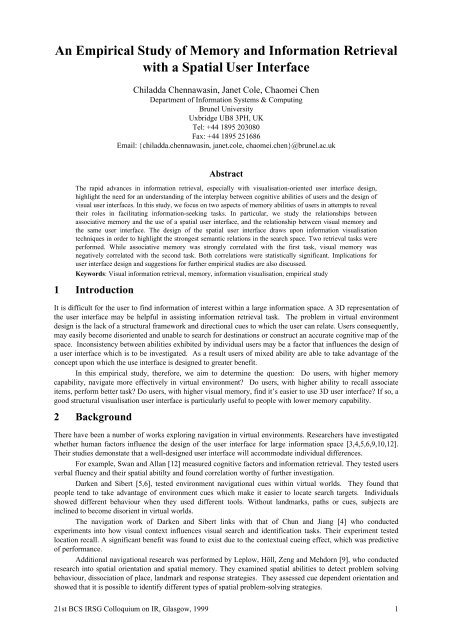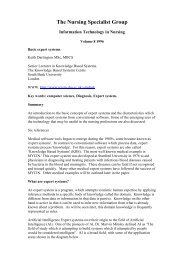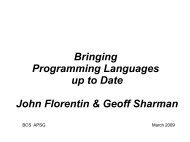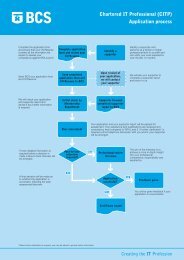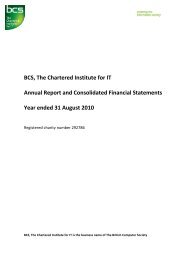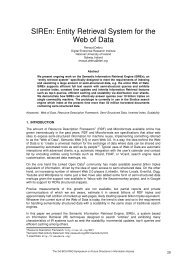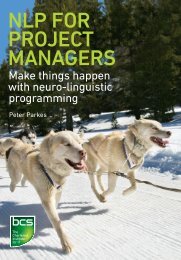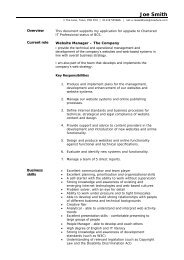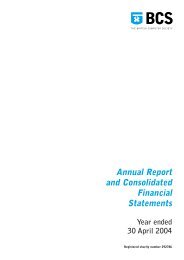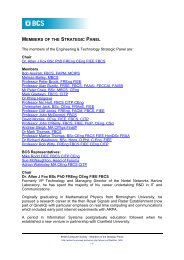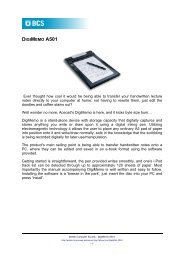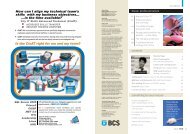An Empirical Study of Memory and Information Retrieval with ... - BCS
An Empirical Study of Memory and Information Retrieval with ... - BCS
An Empirical Study of Memory and Information Retrieval with ... - BCS
Create successful ePaper yourself
Turn your PDF publications into a flip-book with our unique Google optimized e-Paper software.
<strong>An</strong> <strong>Empirical</strong> <strong>Study</strong> <strong>of</strong> <strong>Memory</strong> <strong>and</strong> <strong>Information</strong> <strong>Retrieval</strong><strong>with</strong> a Spatial User InterfaceChiladda Chennawasin, Janet Cole, Chaomei ChenDepartment <strong>of</strong> <strong>Information</strong> Systems & ComputingBrunel UniversityUxbridge UB8 3PH, UKTel: +44 1895 203080Fax: +44 1895 251686Email: {chiladda.chennawasin, janet.cole, chaomei.chen}@brunel.ac.ukAbstractThe rapid advances in information retrieval, especially <strong>with</strong> visualisation-oriented user interface design,highlight the need for an underst<strong>and</strong>ing <strong>of</strong> the interplay between cognitive abilities <strong>of</strong> users <strong>and</strong> the design <strong>of</strong>visual user interfaces. In this study, we focus on two aspects <strong>of</strong> memory abilities <strong>of</strong> users in attempts to revealtheir roles in facilitating information-seeking tasks. In particular, we study the relationships betweenassociative memory <strong>and</strong> the use <strong>of</strong> a spatial user interface, <strong>and</strong> the relationship between visual memory <strong>and</strong>the same user interface. The design <strong>of</strong> the spatial user interface draws upon information visualisationtechniques in order to highlight the strongest semantic relations in the search space. Two retrieval tasks wereperformed. While associative memory was strongly correlated <strong>with</strong> the first task, visual memory wasnegatively correlated <strong>with</strong> the second task. Both correlations were statistically significant. Implications foruser interface design <strong>and</strong> suggestions for further empirical studies are also discussed.Keywords: Visual information retrieval, memory, information visualisation, empirical study1 IntroductionIt is difficult for the user to find information <strong>of</strong> interest <strong>with</strong>in a large information space. A 3D representation <strong>of</strong>the user interface may be helpful in assisting information retrieval task. The problem in virtual environmentdesign is the lack <strong>of</strong> a structural framework <strong>and</strong> directional cues to which the user can relate. Users consequently,may easily become disoriented <strong>and</strong> unable to search for destinations or construct an accurate cognitive map <strong>of</strong> thespace. Inconsistency between abilities exhibited by individual users may be a factor that influences the design <strong>of</strong>a user interface which is to be investigated. As a result users <strong>of</strong> mixed ability are able to take advantage <strong>of</strong> theconcept upon which the use interface is designed to greater benefit.In this empirical study, therefore, we aim to determine the question: Do users, <strong>with</strong> higher memorycapability, navigate more effectively in virtual environment? Do users, <strong>with</strong> higher ability to recall associateitems, perform better task? Do users, <strong>with</strong> higher visual memory, find it’s easier to use 3D user interface? If so, agood structural visualisation user interface is particularly useful to people <strong>with</strong> lower memory capability.2 BackgroundThere have been a number <strong>of</strong> works exploring navigation in virtual environments. Researchers have investigatedwhether human factors influence the design <strong>of</strong> the user interface for large information space [3,4,5,6,9,10,12].Their studies demonstate that a well-designed user interface will accommodate individual differences.For example, Swan <strong>and</strong> Allan [12] measured cognitive factors <strong>and</strong> information retrieval. They tested usersverbal fluency <strong>and</strong> their spatial abitilty <strong>and</strong> found correlation worthy <strong>of</strong> further investigation.Darken <strong>and</strong> Sibert [5,6], tested environment navigational cues <strong>with</strong>in virtual worlds. They found thatpeople tend to take advantage <strong>of</strong> environment cues which make it easier to locate search targets. Individualsshowed different behaviour when they used different tools. Without l<strong>and</strong>marks, paths or cues, subjects areinclined to become disorient in virtual worlds.The navigation work <strong>of</strong> Darken <strong>and</strong> Sibert links <strong>with</strong> that <strong>of</strong> Chun <strong>and</strong> Jiang [4] who conductedexperiments into how visual context influences visual search <strong>and</strong> identification tasks. Their experiment testedlocation recall. A significant benefit was found to exist due to the contextual cueing effect, which was predictive<strong>of</strong> performance.Additional navigational research was performed by Leplow, Höll, Zeng <strong>and</strong> Mehdorn [9], who conductedresearch into spatial orientation <strong>and</strong> spatial memory. They examined spatial abilities to detect problem solvingbehaviour, dissociation <strong>of</strong> place, l<strong>and</strong>mark <strong>and</strong> response strategies. They assessed cue dependent orientation <strong>and</strong>showed that it is possible to identify different types <strong>of</strong> spatial problem-solving strategies.21st <strong>BCS</strong> IRSG Colloquium on IR, Glasgow, 1999 1
<strong>An</strong> <strong>Empirical</strong> <strong>Study</strong> <strong>of</strong> <strong>Memory</strong> <strong>and</strong> <strong>Information</strong> <strong>Retrieval</strong> <strong>with</strong> a Spatial User InterfaceWhereas Mallot, Gillner, van Veen <strong>and</strong> Bülth<strong>of</strong>f [10], looked at three mechanisms <strong>of</strong> spatial memory: pathintegration, guidance <strong>and</strong> direction. They show that spatial relations can be learned from exploration in a virtualenvironment even one that may be subject to restricted viewing conditions. They have four important findings.The effect <strong>of</strong> viewing condition found that the error rate dropped as more information was provided. Transfer <strong>and</strong>latent learning showed that there was a reduced error rate for later search tasks compared <strong>with</strong> earlier ones.Persistence indicated that subject's movement decisions were based on simple associations, <strong>and</strong> subjectdifferences being the individual differences <strong>of</strong> the test subjects.Subject differences effecting performance results were also observed during the work <strong>of</strong> Chen <strong>and</strong>Czerwinski [3] who conducted an empirical study in an attempt to underst<strong>and</strong> the role <strong>of</strong> individuals’ spatialabilities in virtual environmental navigation. They found that the visualised semantic stucture <strong>of</strong> 3D userinterface facilitated users’ navigation strategies <strong>and</strong> their spatial memories. In addition, users’ spatial memorywere significantly correlated <strong>with</strong> their spatial abilities. We extend the work <strong>of</strong> Chen <strong>and</strong> Czerwinski whereas ourresearch distinguishes the effect upon associative <strong>and</strong> visual memory <strong>of</strong> a spatial user interface. All these studiessuggest that spatial user interface design is closely related to individual user cognitive ability.3 Human <strong>Memory</strong>Humans differ in how they h<strong>and</strong>le the same information <strong>and</strong> confront the same problem. <strong>An</strong> explanation <strong>of</strong> thedifference in cognitive style <strong>and</strong> strategies such as learning <strong>and</strong> recall is probably due to the memory abilities <strong>of</strong>each individual. In our study, we focus on two aspects <strong>of</strong> memory abilities, associative memory <strong>and</strong> visualmemory, <strong>of</strong> users in attempts to reveal their roles in facilitating information-seeking tasks.Associative memory involves the ability to recall one part <strong>of</strong> a previously learned when the other part <strong>of</strong>the pair is presented. Using the picture-number combination (see Fig. 1) tests this ability. The test consists <strong>of</strong>pictures <strong>and</strong> numbers. After studying both the pictures <strong>with</strong> the numbers, the subjects are required to memorisetheir association <strong>and</strong> reproduce them.46Figure 1: Picture-Number CombinationThe other part <strong>of</strong> our study is visual memory, which is the ability to remember the configuration, location,<strong>and</strong> orientation <strong>of</strong> figural material. Using the shape memory test (see Fig. 2), the ability to remember a group <strong>of</strong>shapes <strong>and</strong> their positions in relation to each other is tested. Subjects are required to study the image, noting thedifferent shapes <strong>and</strong> their orientation. They are then presented <strong>with</strong> similar grouped images <strong>and</strong> they mustindicate which <strong>of</strong> them match in shape <strong>and</strong> orientation.Figure 2: A Group <strong>of</strong> Shapes <strong>and</strong> Their Position in Relation to Each Other21st <strong>BCS</strong> IRSG Colloquium on IR, Glasgow, 1999 2
<strong>An</strong> <strong>Empirical</strong> <strong>Study</strong> <strong>of</strong> <strong>Memory</strong> <strong>and</strong> <strong>Information</strong> <strong>Retrieval</strong> <strong>with</strong> a Spatial User Interface4 MethodThe following method was used in the empirical study.4.1 SubjectsTen subjects, six males <strong>and</strong> four females raging in age from 25 to 40 participated. All subjects were computerliterate,but <strong>with</strong> varying degrees <strong>of</strong> experience <strong>with</strong> virtual environments.4.2 User Interface DesignThe user interface prototype was designed by Chen [1,2]. It is a hypermedia information system emphasising therole <strong>of</strong> intrinsic inter-document relationships in structuring <strong>and</strong> visualising a large hypermedia information space.Salient patterns in these relationships are extracted <strong>and</strong> visualised in a simple <strong>and</strong> intuitive associated network.The spatial layout <strong>of</strong> a visualisation is optimised such that closely related documents are placed near to each other<strong>and</strong> only those <strong>with</strong> an intrinsic connection among them are shown to users as automatically generated virtuallinks. Further details <strong>of</strong> models <strong>and</strong> algorithms can be found in [1,2].The semantic space <strong>of</strong> the user interface consists <strong>of</strong> 169 papers published in the three ACM SIGCHIconference proceedings (ACM 1995, ACM 1996 <strong>and</strong> ACM 1997). According to semantic similarities, papers arestructured <strong>and</strong> visualised as similar topics papers tended to be grouped near to each other. A virtual link structurewas also automatically generated. Papers are visualised as coloured spheres in a connected network.The user interface was based on the Netscape Comunication 4.0 browser <strong>and</strong> its COSMO Player 2.0viewer. Splitting the screens into two frames, the virtual world was displayed in the left-h<strong>and</strong> side <strong>and</strong> theabstract <strong>of</strong> the papers selected was displayed in the other side (see Fig. 3). Colour spheres <strong>of</strong> each paper arelabelled <strong>with</strong> the initials <strong>of</strong> authors. When the users point the mouse cursor at a sphere, the title <strong>of</strong> the paper popsup. Alternatively, if the users click on the sphere, the abstract will appear in the right-h<strong>and</strong> side frame. The userscan operate the virtual world in various ways, for example, they can walk towards the world by dragging themouse forward. By reversing this process, the users can overview the entire space at a glance.The abstracts <strong>of</strong> the papers are stored on a web server at Brunel University. The experiment wasconducted on a PC <strong>with</strong> 233 MHz CPU <strong>and</strong> 32 Mb RAM, <strong>with</strong> a 17-inch display monitor.Figure 3: The User Interface <strong>of</strong> CHI Proceedings4.3 ProcedureThe study included pre-test <strong>and</strong> post-test phases. All subjects were arranged to perform the test, under a neutralmood, which was created through the medium <strong>of</strong> general conversation, in the following areas.• <strong>Memory</strong> pre-tests. Associative memory <strong>and</strong> visual memory scores were collected from the st<strong>and</strong>ardmemory test <strong>of</strong> [7]. Each test contained two parts <strong>and</strong> required apploximately fifteen minutes to completethe task.21st <strong>BCS</strong> IRSG Colloquium on IR, Glasgow, 1999 3
<strong>An</strong> <strong>Empirical</strong> <strong>Study</strong> <strong>of</strong> <strong>Memory</strong> <strong>and</strong> <strong>Information</strong> <strong>Retrieval</strong> <strong>with</strong> a Spatial User Interface• Pre-test Usability questionnaires. The questionnaire was developed by Micros<strong>of</strong>t usability engineers. Thequestions ask about typical computer-use <strong>of</strong> the subjects.• Tests. On the following day, subjects were asked to perform two tasks using the designed prototype. <strong>An</strong>explanation <strong>and</strong> a demonstation on how to use the COSMO Player 2.0 was given to the subjects. It wasensured that all subjects were familiar <strong>with</strong> the comm<strong>and</strong>s to manipulate the virtual word.Each subject was given ten minutes for Task 1. In Task 1, subjects were asked to find as manypapers as they could on the topic visualisation techniques <strong>and</strong> information visualisation systems. Subjectscould find relevant papers by examining them in the following areas: Title, Abstract, Keywords, <strong>and</strong>Content. Highly relevant papers could be simply detected from their title. However, where relevancy wasdifficult to determine then the abstract, keywords or content were explored.Once they found a relevant paper, they were instructed to save the abstract <strong>of</strong> the paper to a localdirectory on their PC. After Task 1 was completed, subjects were asked to complete a brief spatialmemory test. For this memory test, subjects were asked to sketch the shape <strong>of</strong> the visualised semanticspace as best they could from their memory. The test was designed to find out what subjects couldremember after having searched through the designed user interface.For Task 2, subjects were asked to find five papers on the topic information structure, includingtopic structures, spatial structures <strong>and</strong> implicit structures. Once they found a relevant paper, they wereinstructed to save the abstract <strong>of</strong> the paper to a local directory on their PC. After Task 2 was completed,subjects were asked to name the cluster <strong>of</strong> papers in the visualised semantic space. The test was designedto find out whether subjects could summarise groups <strong>of</strong> papers associated <strong>with</strong> distinctive structurepatterns <strong>and</strong> what naming schemes they might use. The meaningful finding could be used in future design.• Post-test. A st<strong>and</strong>ard post-test questionnaire <strong>of</strong> Micros<strong>of</strong>t was used to assess usability issues <strong>and</strong> usersatisfaction. The questionnaire consisted <strong>of</strong> three parts <strong>of</strong> questions about overall satisfaction, usabilityissues <strong>and</strong> user interface design.4.4 ResultsQualitative <strong>and</strong> quantitative performance measures were collected during the test session. Correlation wascomputed between task performances <strong>and</strong> subjects’ memory scores. In addition, usability <strong>and</strong> user satisfactionrating were assessed.4.4.1 Task PerformanceThe associate memory <strong>and</strong> visual memory scores were assessed. Each memory test contained two repeated parts.Scores from the two parts were averaged <strong>and</strong> used. A one-way <strong>An</strong>alysis <strong>of</strong> Variance (ANOVA) was computedbetween memory scores <strong>and</strong> task performances. The task performance statistics <strong>and</strong> their correlation <strong>with</strong>memory scores are presented in table 1. The number <strong>of</strong> abstracts saved by each individual was positivelycorrelated <strong>with</strong> associative memory test in Task 1. The table shows that associative memory was high significant(P < .001) in task 1. However, visual memory was not significant in performing task 1. The number <strong>of</strong> abstractssaved by each individual was negatively correlated <strong>with</strong> both memory tests in Task 2.<strong>Memory</strong> tests Associative VisualTasks <strong>Memory</strong> <strong>Memory</strong>Task 1 r = .85552p = .003Task 2 r = - .5750p = .068r = .1796p = .335r = -.6491p = .041Table 1: Task Performance Statistics <strong>and</strong> Their Correlation <strong>with</strong> <strong>Memory</strong> Score4.4.2 Navigation StrategiesMany subjects directed their initial focus towards the central circle <strong>of</strong> the interface. Subjects would adjust themodel to an easeful position to start navigation. Some subjects spent times to manipulate the virtual world beforestart to search. However, some subjects went straight to look for the paper <strong>with</strong>out changing the position <strong>of</strong> themodel. Branches <strong>with</strong> more nodes were normally examined in an initial stage. Branching points, where twobranches were connected, were vital in their initial analyses.21st <strong>BCS</strong> IRSG Colloquium on IR, Glasgow, 1999 4
<strong>An</strong> <strong>Empirical</strong> <strong>Study</strong> <strong>of</strong> <strong>Memory</strong> <strong>and</strong> <strong>Information</strong> <strong>Retrieval</strong> <strong>with</strong> a Spatial User Interface4.4.3 Spatial <strong>Memory</strong>All subjects remembered the shape <strong>of</strong> the central circle. However, they remembered details vary from oneanother. Figure 4 shows the sketches <strong>of</strong> the structures from four different subjects.Figure 4: Subject’s Sketches <strong>of</strong> the Semantic <strong>Information</strong> Space Searched during the <strong>Study</strong>In (a), the subject was able to remember most details about the branches surrounding <strong>and</strong> strokes insidethe central circle. The details were also the most accurate. The subject who sketched this structure achieved thehighest score in task one. In (b), the subject drew less detail structure. However, the subjects emphasised eachnode in his drawing. He gave more detail in the branches that he had been visited for sometimes. In (c),although the sketch was not accurate, the subject sketched the branches that he had been focused <strong>and</strong> searched on.He drew in more detail at the first branch he started <strong>and</strong> spent times for it. In (d), the structure was less in detail<strong>and</strong> accuracy. The subject achieved the lowest score in Task 1.4.4.4 Categorisation <strong>and</strong> AbstractionThe categorisation <strong>and</strong> abstraction task helps us underst<strong>and</strong> how individuals would refer to distinctive structuralpatterns <strong>and</strong> what features associated <strong>with</strong> these patterns are useful in future design. All subjects were able togive names to structural patterns. Some subjects wanted to check at each cluster again before they could providea name. Some subjects gave the cluster names from things that they are familiar <strong>and</strong> easy to remember such ascomet, dolphin head <strong>and</strong> western. However, some subjects used a content-based naming scheme. For example,the names such as "visualisation", "user interface", <strong>and</strong> "interaction technique" were given to clusters that containthis information. The central circle is named as general, "mothership’s orbit", "universe", <strong>and</strong> "main ring".4.4.5 User SatisfactionThe post-test questionnaire was used to assess usability issues <strong>and</strong> user satisfaction. The questionnaire consists <strong>of</strong>three parts <strong>of</strong> questions about overall satisfaction, usability issues <strong>and</strong> user interface design. The details <strong>of</strong> thevalidated questionnaire are described in [8].The majority <strong>of</strong> the subjects would recommend this system to others, on average (Mean 3.30, S.D. =1.49). The scores were slightly below the average on the question <strong>of</strong> like the system or use it on a regular basis(see Table 2).21st <strong>BCS</strong> IRSG Colloquium on IR, Glasgow, 1999 5
<strong>An</strong> <strong>Empirical</strong> <strong>Study</strong> <strong>of</strong> <strong>Memory</strong> <strong>and</strong> <strong>Information</strong> <strong>Retrieval</strong> <strong>with</strong> a Spatial User InterfaceGlobal Appeal (all ratings are on a 1-5 Likert scale, <strong>with</strong> 1=negative<strong>and</strong> 5 = positive)MeanS.D.I would recommend this s<strong>of</strong>tware to others. 3.30 1.49I like it. 2.90 1.20I would use this s<strong>of</strong>tware on a regular basis 2.78 1.56Table 2: Global Appeal Rating for the User InterfaceMost <strong>of</strong> the subjects described the user interface as "original", "intuitive", "imaginative" <strong>and</strong> "fun". Somefound it lacked predictability. Few found it was confusing <strong>and</strong> boring (see Table 3).Design Satisfaction Mean S.D.Original 4.00 1.07Intuitive 3.50 1.35Imaginative 3.40 0.84Fun 3.20 1.55Predicable 2.80 1.55Confusing 2.20 1.62Not my type <strong>of</strong> program 2.00 1.83Boring 1.40 1.17Table 3: Design Satisfaction Ratings for the User InterfaceMany subjects said that the purpose <strong>of</strong> the s<strong>of</strong>tware was clear. However, the other three usability scoreswere slightly below the average (see Table 4).Usability Mean S.D.Right when I start, the purpose <strong>of</strong> the s<strong>of</strong>tware was clear. 3.80 1.03Right when I started, I knew what I could do. 2.90 1.29It was easy to get where I wanted to go. 2.80 1.03Each area <strong>of</strong> the s<strong>of</strong>tware was clearly marked to indicate my location. 2.20 0.79Table 4: Usability Satisfaction Ratings for the User InterfaceOnline appeal factor ratings were above average. Many subjects liked the unique interface design (Mean= 4.20, S.D. = 0.63). Average rating was low in familiarity.Online Appeal Mean S.D.This s<strong>of</strong>tware feels unique (or different). 4.20 0.63This s<strong>of</strong>tware provides a shared experience (or community). 4.00 0.89This s<strong>of</strong>tware is timely (or up-to-date). 3.89 1.05This s<strong>of</strong>tware is responsive (not too slow). 3.50 1.18This s<strong>of</strong>tware is mentally challenging. 3.44 1.01This s<strong>of</strong>tware is personalised/customisation. 3.38 1.69This s<strong>of</strong>tware has appealing graphics. 3.33 1.22This s<strong>of</strong>tware provides a detailed environment to interact <strong>with</strong> 3.30 1.4921st <strong>BCS</strong> IRSG Colloquium on IR, Glasgow, 1999 6
<strong>An</strong> <strong>Empirical</strong> <strong>Study</strong> <strong>of</strong> <strong>Memory</strong> <strong>and</strong> <strong>Information</strong> <strong>Retrieval</strong> <strong>with</strong> a Spatial User InterfaceOnline Appeal Mean S.D.This s<strong>of</strong>tware provides valuable information. 3.25 1.39This s<strong>of</strong>tware is easy to use. 3.20 1.14This s<strong>of</strong>tware uses cutting edge technology. 3.17 0.98This s<strong>of</strong>tware feels familiar. 2.20 1.75Table 5: Satisfaction Rating for the Online Appeal <strong>of</strong> the User Interface5 DiscussionOur statistical results show a strong positive correlation between memory scores <strong>and</strong> Task 1 performance aspredicted. However, a negative correlation was found <strong>with</strong> consistency between visual memory scores <strong>and</strong> Task 2performance. This may have been due to Task 2 being more difficult in finding a particular topic, especiallywhere the test subject was unfamiliar <strong>with</strong> that topic. This resulted in the observation that subjects needed toexplore a paper’s content more fully. Further research testing could be done on subjects who have a specialistbackground that matches the content. New user models <strong>and</strong> workload assessment tools such as NASA TLX [11],which assesses Mental Dem<strong>and</strong>s, Physical Dem<strong>and</strong>s, Temporal Dem<strong>and</strong>s, Performance, Effort, <strong>and</strong> Frustration,will be examined in future experiments.From our observation <strong>of</strong> navigation strategy, it seemed that people, who understood how the structure wassemantically organised, developed good navigation strategies. This resulted in faster <strong>and</strong> an increased number <strong>of</strong>successful searches.The sketches <strong>of</strong> the overall structure provide an indication <strong>of</strong> how subjects seemed to develop navigationstrategies. Those who produced more detailed drawings appear to perform better tasks. The subject’s memorymay be influenced not only by information visualisation but also by differences in individual ability <strong>and</strong> strategy.When abstracting information from the overall visualised semantic model, people gave it descriptivenames according to what it reminded them <strong>of</strong>. We believe that people used these names as their personall<strong>and</strong>marks.The user satisfaction, usability issues <strong>and</strong> user interface design ratings were above the average. Whenpeople performed the task successfully they would be satisfied <strong>with</strong> the design <strong>and</strong> the usability rating would behigh. This simple but important user satisfaction factor affects the likelihood <strong>of</strong> interface usage. It was suggestedby some subjects that the interface should show where they were or where they had been in order to help themnavigate easier. This possibility will be explored more fully in on-going research.6 ConclusionVirtual environments present a rich field <strong>of</strong> methodological opportunities for research on human cognition,specifically spatial ability. Our purpose in this study was to investigate the factor <strong>of</strong> individuals’ abilities ininformation seeking in virtual environments. We examined the findings <strong>of</strong> other researchers in human factorsinfluencing the design <strong>of</strong> the user interface for a large information space. We focused on the process <strong>of</strong> howmemory acquires <strong>and</strong> retrieves visual information. Within this framework we undertook memory tests <strong>and</strong>assessed them against task performance in the virtual environment.Our findings indicate that while associative memory was strongly correlated <strong>with</strong> the first task, visualmemory was negatively correlated <strong>with</strong> the second task. Both correlations were statistically significant. Thisverifies that a key design element <strong>of</strong> an effective <strong>and</strong> usable 3D interface relies on human memory factors beingtaken into account which tends to equalise users <strong>of</strong> differing abilities.AcknowledgementThis work was in part funded by the Brunel Research Initiative & Enterprise Fund <strong>and</strong> by EPSRC Multimedia<strong>and</strong> Networking Applications Programme (GR/L61088).References1. Chen C. Bridging the gap: The use <strong>of</strong> pathfinder networks in visual navigation. Journal <strong>of</strong> VisualLanguage <strong>and</strong> Computing 1998, pp 267-2862. Chen C. Structuring <strong>and</strong> visualising the WWW <strong>with</strong> Generalised Similarity <strong>An</strong>alysis. In Proceedings <strong>of</strong>Hypertext, New York: ACM Press, 1997, pp 177- 18621st <strong>BCS</strong> IRSG Colloquium on IR, Glasgow, 1999 7
<strong>An</strong> <strong>Empirical</strong> <strong>Study</strong> <strong>of</strong> <strong>Memory</strong> <strong>and</strong> <strong>Information</strong> <strong>Retrieval</strong> <strong>with</strong> a Spatial User Interface3. Chen C. <strong>and</strong> Czerwinski M. Spatial ability <strong>and</strong> visual navigation: an empirical study. The New Review <strong>of</strong>Hypermedia <strong>and</strong> Multimedia, 1997, pp 67-904. Chun M.M. <strong>and</strong> Jiang Y. Contextual Cueing: Implicit Learning <strong>and</strong> <strong>Memory</strong> <strong>of</strong> Visual Context GuidesSpatial Attention. Cognitive Psychology 36, Academic Press, 1998, pp 28-715. Darken R.P. <strong>and</strong> Sibert J.L. A toolset for navigation in virtual environments. In: User Interface S<strong>of</strong>tware<strong>and</strong> Technology, Atlanta, GA: ACM Press, 1993, pp 157-1656. Darken R.P. <strong>and</strong> Sibert J.L. Wayfinding strategies <strong>and</strong> behaviors in large virtual worlds. In: Proceedings<strong>of</strong> CHI’96, ACM 1996, pp 142-1497. Eckstrom R.B., French J.W., Harman H.H. <strong>and</strong> Derman D. Kit <strong>of</strong> factor-referenced cognitive test.Princeton, NJ: Educational Testing Service, 19768. Kanerva A., Keeker K., Risden K., Schuh E. <strong>and</strong> Czerwinski M. Web usability research at Micros<strong>of</strong>tCorporation. In: J. Ratner, E.Grosse <strong>and</strong> C. Forsythe (eds.), Human Factors for World Wide WebDevelopment, New York: Lawrence Erlbaum, 1997, pp 207-2249. Leplow B., Höll D., Zeng L. <strong>and</strong> Mehdorn M. Spatial Orientation <strong>and</strong> Spatial <strong>Memory</strong> Within a'Locomotor Maze' for Humans. In C.Freksa, C.Habel <strong>and</strong> K.F. Wender (Eds.): Spatial Cognition, <strong>An</strong>Interdisciplinary Approach to Representing <strong>and</strong> Processing Spatial Knowledge. LNAI 1404, Springer-Verlag, 1998, pp 429-44610. Mallot H.A., Gillner S., van Veen H.A.H.C. <strong>and</strong> Bülth<strong>of</strong>f H.H. Behavioural experiments in spatialcognition using virtual reality. In C.Freksa, C.Habel <strong>and</strong> K.F. Wender (Eds.): Spatial Cognition, <strong>An</strong>Interdisciplinary Approach to Representing <strong>and</strong> Processing Spatial Knowledge. LNAI 1404, Springer-Verlag, 1998, pp 447-46711. NASA Ames Research Center, Human Performance Research Group. NASA Task Load Index (TLX).WWW: http://cseriac.flight.wpafb.af.mil, 199912. Swan R.C. <strong>and</strong> Allan J. Aspect Windows, 3-D Visualizations, <strong>and</strong> indirect comparisons <strong>of</strong> informationretrieval systems. In: Proceedings <strong>of</strong> the 21 st annual international ACM SIGIR conference on Research <strong>and</strong>development in information retrieval, 1998, pp 173-18121st <strong>BCS</strong> IRSG Colloquium on IR, Glasgow, 1999 8


